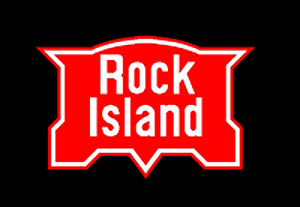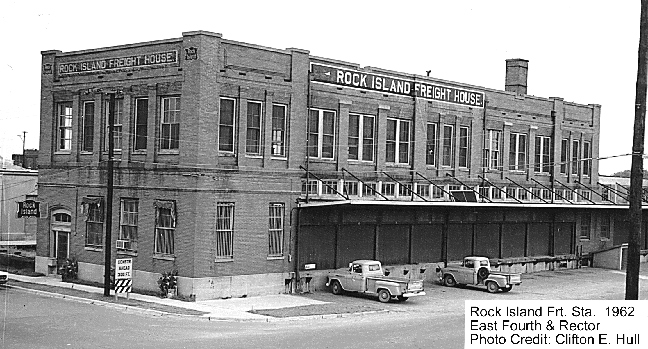 |
Rock Island East Fourth Street Freight Station |

|
The unfortunate demolition of Little Rock's historic Choctaw Route freight station in November 2001 raised public interest in four other railroad freight stations which had once served the Little Rock-North Little Rock area. In terms of longevity, the station that survived almost as long as the Choctaw station was the nearby Rock Island station, pictured above. The Chicago, Rock Island & Pacific Railway, successor to the Choctaw Route, built this freight station on the northeast corner of Rector & East Fourth Streets when freight volume dictated a need for a larger structure. As discussed in the Historical Significance section of this website, other area freight stations were operated by Missouri Pacific and Cotton Belt. These cavernous brick structures were constructed to facilitate the transfer of freight from boxcars to wagons or trucks, usually for businesses which were shipping in less-than-carload (LCL) quantities. Profitable operation of these very labor intensive freight houses was dependent upon a large volume of LCL traffic. After World War II, the end of gasoline rationing and the rapid development of government subsidized highways allowed the trucking industry to undercut railroad freight rates and capture much of the LCL business. Beginning in the mid-1950s, freight railroads began exiting the less-than-carload freight transportation market after truckers had siphoned away sufficient volume to render the remaining service unprofitable. By the mid-1960s, the freight stations stood vacant, costly dinosaurs from an earlier era. Both of the Missouri Pacific stations were razed by 1969, and the Cotton Belt station fell victim to a North Little Rock urban renewal project in the early 1970s. When the Rock Island acquired the CO&G in 1902, the railroad also inherited the Choctaw's East Second Street freight house. By 1911, freight traffic had overwhelmed the Choctaw freight station, and plans were drawn for a new freight house on East Fourth at Rector. Initial grading for station trackage was completed in 1911 before a recession stalled the project. When the economy recovered, a new brick freight station was erected and opened in 1912, replacing the Choctaw freight station. The new Rock Island freight station was 46 feet wide and 500 feet long, twice the size of the Choctaw freight station. The westernmost part of the structure (46 feet by 100 feet) was two-story, providing office space for Rock Island freight clerks. Tracks extended along the north side of the structure, and covered platforms allowed simultaneous unloading from several tracks on the east end of the building. Heavy paving bricks formed roadways around other tracks to facilitate outside freight transfer. In 1926, additional platforms were constructed to accommodate loading and unloading of automobiles in boxcars, the standard mode of automobile shipment of that era. Rock Island continued to use this freight station, at least for offices, into the mid-1960s. The structure was vacated about 1968 when the building and land (including the Choctaw passenger station) were sold to the Arkansas Gazette, and all remaining Rock Island offices were consolidated at the railroad's Biddle Yard. The building was subsequently leased to Arkansas Foundry and other tenants, and ownership passed to Walter Hussman when his company purchased the Arkansas Gazette. As the unused building fell into disrepair, roof defects and broken windows allowed water leakage to cause structural damage, a restoration concern that was not present in the older but better protected Choctaw freight station. Construction of the Rock Island station varied significantly from that of the Choctaw freight station, being of a more utilitarian design which exhibited few of the architectual embellishments seen on the Choctaw freight station. Like most commercial buildings that survived for 80-plus years, the RI freight station was historically significant. Had there been an awareness that the structure was about to be demolished by its present owner, the preservation community might have acted to try and preserve the structure. Unfortunately, the building was razed in March 2001 with little advance notice - eight months before the Choctaw freight station's controversial demise. In terms of architectural and historic significance, there was a considerable difference between the Choctaw freight station and the Rock Island freight station. The Choctaw freight station was constructed by a regional railroad which had just chosen Little Rock as its system headquarters. No expense was spared by company engineers who were determined that the style of the structure would appropriately represent the strength and presence of the Choctaw Route in its new home city. The Choctaw freight station was located in close proximity to the Choctaw passenger station, the Choctaw general office building and the Choctaw's Arkansas River bridge, forming what could have been a unique historic district. Because the adjacent Choctaw freight and passenger stations were constructed by the same company at the same time, they provided an extremely valuable historic contrast between passenger and freight needs at the turn of the century. The Rock Island station, by comparison, was built by a carrier which served 14 other states. Little Rock was an important station, but no more so that numerous other large cities along the Rock Island. The Rock Island's more modern structure focused mainly on economical construction and basic function, with much less corporate interest in architectural style or making a statement about the railroad's presence in the community.
|